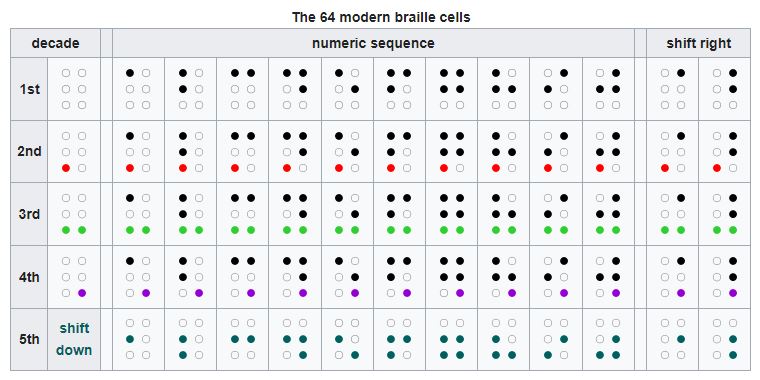French to Braille Translator
Louis Braille, the inventor of braille script, was a Frenchman. He designed braille to be used for the French language. Therefore French braille is the original braille script. All other braille scripts have originated from the French braille. The International Braille script has adopted 25 letters from the French braille.
Why the letter w is weird in braille? Louis Braille arranged 25 letters of his script in a numerical order. These 25 letters did not include the letter w because French did not use the letter w. When braille script spread to other countries where the letter w was used, it was added at the end, i.e. after 25 letters. This is the reason why English braille alphabet, for example, follows the letter order as u, v, x,y, z and w is placed after z.
Numbers in French braille: The French braille uses both international braille number system as well as the Antoine braille digits. These days, in France, the Antoine braille numbers are used in mathematics and other academic braille material. Dot-6 is used as number indicator in Antoine digits. This French to Braille translator uses international number by default. I will soon integrate the Antoine digits as well in this tool.
Braille pattern ⠻ is used in French for ï (in Spanish Braille the same pattern is used for the consonant ñ).
This French to Braille Translator tool has been developed by Lalit Kumar 'Samyak Lalit'.
Louis Braille: Inventor of the Braille Script
Modern Braille script was invented by a French inventor named Louis Braille. Louis was born in Coupvray, France on 04 January 1809. His father was a leather-maker. At the age of three, little Louis was playing in his father's workshop and he accidentally stuck a stitching awl in one of his eyes. Later, his injured eye got infected. Due to lack of antibiotics, soon, the infection spread to his other eye too. Gradually, by the age of five, the Louis Braille lost sight in both of his eyes.
Louis Braille studied at the Royal Institute for Blind Youth in Paris. There he met Charles Barbier -- the inventor of the night writing script (also a tactile script). Braille began working on a tactile script as an improvement over night writing. It took him two years but, in 1824, he finally created the Braille script with a six-dot system, in 1824, just at the age of 15 years. His headmaster gave him a dictation to test his new script. Louis wrote the entire article being dictated from the newspaper in his newly developed script and then read it back word-to-word.
Braille Alphabet: 6-dot Cell
The braille script designed by Louis Braille uses tactile patterns made with six raised dots arranged in a 3 x 2 matrix, called the braille cell. One or more braille cells may represent a letter, number, punctuation or a symbol. The following table shows the Unicode Braille characters representing various braille cells.
| ⠀------ | ⠁1 | ⠃12 | ⠉14 | ⠙145 | ⠑15 | ⠋124 | ⠛1245 | ⠓125 | ⠊24 | ⠚245 | ⠈4 | ⠘45 |
| ⠄3 | ⠅13 | ⠇123 | ⠍134 | ⠝1345 | ⠕135 | ⠏1234 | ⠟12345 | ⠗1235 | ⠎234 | ⠞2345 | ⠌34 | ⠜345 |
| ⠤36 | ⠥136 | ⠧1236 | ⠭1346 | ⠽13456 | ⠵1356 | ⠯12346 | ⠿123456 | ⠷12356 | ⠮2346 | ⠾23456 | ⠬346 | ⠼3456 |
| ⠠6 | ⠡16 | ⠣126 | ⠩146 | ⠹1456 | ⠱156 | ⠫1246 | ⠻12456 | ⠳1256 | ⠪246 | ⠺2456 | ⠨46 | ⠸456 |
| ⠀ | ⠂2 | ⠆23 | ⠒25 | ⠲256 | ⠢26 | ⠖235 | ⠶2356 | ⠦236 | ⠔35 | ⠴356 | ⠐5 | ⠰56 |

As per the international convention, braille is always written in left-to-right direction. This convention is followed even for the languages that are written right-to-left. For example, Arabic is written right-to-left, but Arabic braille is written left-to-right.
Notes
Note 1: This braille translation tool and this page uses Unicode braille characters. Without a properly configured computer/mobile device, you may see question marks, boxes, or other symbols instead of braille characters. If that's the case with you, please contact your computer engineer.
Note 2: Please note that software cannot do a perfect braille translation. Many decisions regarding how to translate something into braille have to be taken by human translators. This is true especially in case of Grade 2 (contracted) braille. This braille translation tool attempts to achieve as much accuracy as possible through a program.
Contact: I welcome your suggestions for improvement in this tool. Also, please let me know if you find any errors. Email me on contact.wecapable AT gmail.com